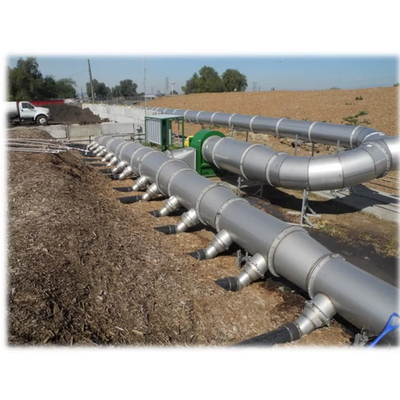

- Home
- Companies
- Engineered Compost Systems (ECS)
- Products
- ECS - Composting Biofilters

ECS - Composting Biofilters
Biofilters are a well-established method for controlling odorous and volatile organic compound air emissions from composting operations. When designed and operated per Best Management Practices they routinely reduce VOC and odor emissions by more than 95%. ECS has designed and provided the air distribution, control, and monitoring systems for dozens of biofilters at large composting facilities and processing buildings such as MRF’s. In addition, we’ve measured and improved the scrubbing efficiency of many biofilters (we know what makes them tick).
Types of biofilter air distribution
Good biofilter designs distribut the air relatively evenly across the bottom of the media. The two main approaches include pipe on grade, or suspended floors.
The first example below shows a pipe on grade biofilter. A plenum provides air to a series of pipes that run under the biofilter media. These have an engineered hole design to provide uniform aeration along their length. Pipe on grade biofilters tend to cost less, and work well in locations where it is challenging to pour concrete (ie capped surface of a landfill)
The other common biofilter uses a suspended floor to distribute the air. Pre-stressed and pre-drilled concrete panels sit on top of pedestals to form a below grade air plenum. Suspended floor biofilters provide excellent air distribution, and excel at capturing condensation and surface water.
Biofilters can be used to process air directly from composting, or from other sources. We commonly see organics handling buildings also require biofiltration if they exist in an odor sensitive location. Depending on the required air change rate, this can often require the biofilter to treat very large volumes of air. Fortunately, their are some benefits of combining these two applications:
- Compost process air is often hot, and can overheat the biofilter (killing the microbial community) if not cooled before entering the biofilter. Blending in relatively dry, cool, building air can decrease the average enthalpy, resulting in a better temperature air entering the biofilter.
- Building air is often dusty and full of particulate matter. While this can require some maintenance on fans and ductwork that handles the air, biofilters are great at removing particulate matter.
- Biofilters tend to work well when the chemical loading is not excessively high. Blending air streams can dilute a high concentration of compost exhaust….although it may still be worthwhile to review what is causing the heaving loading rates.
- Biofilters require high average humidity. Several factors including surface irrigation, weather, and entering air conditions impact the moisture level. For composting only applications, blowing humid exhaust air works well to keep the humidity high. Building only applications tend to desicate the biofilter, and require in-line duct humidification. But combining airstreams can usually acheive adequately high humidify levels.
Whether needed for a building, a compost system, or both – biofilters are great at mitigating odor causing volatile organic compounds, and particulate matter in an air stream.
